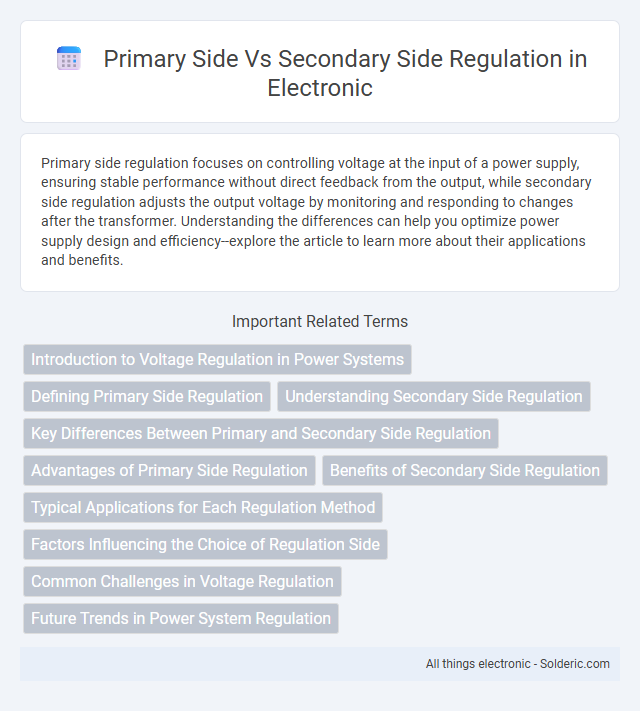Primary side regulation focuses on controlling voltage at the input of a power supply, ensuring stable performance without direct feedback from the output, while secondary side regulation adjusts the output voltage by monitoring and responding to changes after the transformer. Understanding the differences can help you optimize power supply design and efficiency--explore the article to learn more about their applications and benefits.
Comparison Table
| Aspect | Primary Side Regulation | Secondary Side Regulation |
|---|---|---|
| Definition | Voltage or current regulation performed on the primary (input) side of a transformer or converter. | Voltage or current regulation performed directly on the secondary (output) side of a transformer or converter. |
| Control Location | Primary winding or input circuit. | Secondary winding or output circuit. |
| Feedback Source | Indirect measurement, often via transformer primary parameters. | Direct feedback from output voltage or current. |
| Accuracy | Lower, due to indirect feedback and transformer losses. | Higher, since output parameters are directly measured and regulated. |
| Complexity | Lower system complexity, fewer components on secondary side. | Higher complexity, requires additional components like optocouplers. |
| Cost | Generally lower cost due to fewer components. | Higher cost because of extra sensing and feedback components. |
| Isolation Requirements | Less strict, since regulation is done before isolation. | Requires isolated feedback circuitry to maintain safety. |
| Application Examples | Offline AC-DC power supplies, simple switched-mode power supplies. | Precision power supplies, battery chargers, regulated DC output. |
Introduction to Voltage Regulation in Power Systems
Voltage regulation in power systems ensures consistent output voltage despite fluctuations in load or input conditions. Primary side regulation controls voltage at the source before the transformer, while secondary side regulation adjusts voltage after the transformer to maintain stability. Understanding these methods helps you optimize power quality and protect sensitive equipment.
Defining Primary Side Regulation
Primary Side Regulation refers to a method of controlling the output voltage of a power supply by monitoring and adjusting parameters directly on the primary side of the transformer, without using a feedback loop from the secondary side. This technique relies on sensing the primary current or voltage to maintain stable output characteristics, simplifying circuit design and improving reliability. Your choice of Primary Side Regulation can reduce the need for optocouplers and enhance system efficiency in isolated power supplies.
Understanding Secondary Side Regulation
Secondary side regulation controls the output voltage by adjusting parameters directly on the transformer's secondary side, ensuring precise voltage stability despite load variations. This method improves the response time and accuracy of voltage adjustments compared to primary side regulation, making it ideal for sensitive electronic applications. Understanding secondary side regulation helps you optimize power supplies for consistent performance and enhanced load regulation.
Key Differences Between Primary and Secondary Side Regulation
Primary side regulation controls the power supply using feedback from the input or primary side, often relying on indirect measurements like input voltage and current, which enhances efficiency by eliminating the need for an optocoupler. Secondary side regulation directly monitors the output voltage or current, providing precise control and faster response to load changes, which improves output accuracy and stability. Your choice between these methods depends on design priorities such as cost, complexity, and the desired level of output regulation precision.
Advantages of Primary Side Regulation
Primary Side Regulation offers several advantages, including simplified circuit design by eliminating the need for optical isolation and feedback components on the secondary side. This approach reduces overall system cost and improves reliability due to fewer components and connections. It also provides faster response times and better efficiency in power supply regulation, enhancing performance in low-power applications.
Benefits of Secondary Side Regulation
Secondary side regulation offers precise voltage control directly at the load, minimizing voltage drops caused by wiring resistance and improving overall system stability. This approach enhances dynamic response to load changes, ensuring better performance in sensitive electronic applications. Your devices benefit from increased accuracy and reduced noise, leading to improved reliability and lifespan.
Typical Applications for Each Regulation Method
Primary side regulation is commonly used in low to medium power applications such as chargers, adapters, and LED drivers where cost-effectiveness, simplicity, and reduced component count are critical. Secondary side regulation is preferred in high-precision power supplies, including server power modules, communication equipment, and industrial automation systems, due to its superior voltage accuracy and fast transient response. Each method suits different design requirements: primary side for lower cost and fewer components, secondary side for tighter voltage regulation and advanced feedback control.
Factors Influencing the Choice of Regulation Side
Factors influencing the choice between primary side and secondary side regulation in power supplies include cost constraints, complexity of implementation, and desired accuracy of voltage control. Primary side regulation reduces component count and cost by eliminating optocouplers but may provide less precise output voltage regulation compared to secondary side regulation, which uses feedback directly from the output. Design priorities such as isolation requirements, load variation tolerance, and efficiency objectives significantly impact the selection of regulation methodology.
Common Challenges in Voltage Regulation
Primary side and secondary side regulation both face challenges in maintaining stable voltage outputs due to load variations and component tolerances. Primary side regulation struggles with accurately sensing the output voltage indirectly, leading to potential overshoot or undershoot during transient conditions. Secondary side regulation, while offering direct feedback, can encounter issues with increased complexity and cost, as well as slower response times impacting overall voltage stability.
Future Trends in Power System Regulation
Future trends in power system regulation emphasize advanced control techniques integrating artificial intelligence and machine learning to enhance both primary side and secondary side regulation efficiency. Decentralized energy resources and smart grid technologies are driving more adaptive and autonomous regulation strategies, optimizing voltage stability and frequency control dynamically. Your power systems will increasingly rely on predictive analytics and real-time data to balance load fluctuations and renewable energy integration across the primary and secondary sides.
Primary Side vs Secondary Side Regulation Infographic

 solderic.com
solderic.com